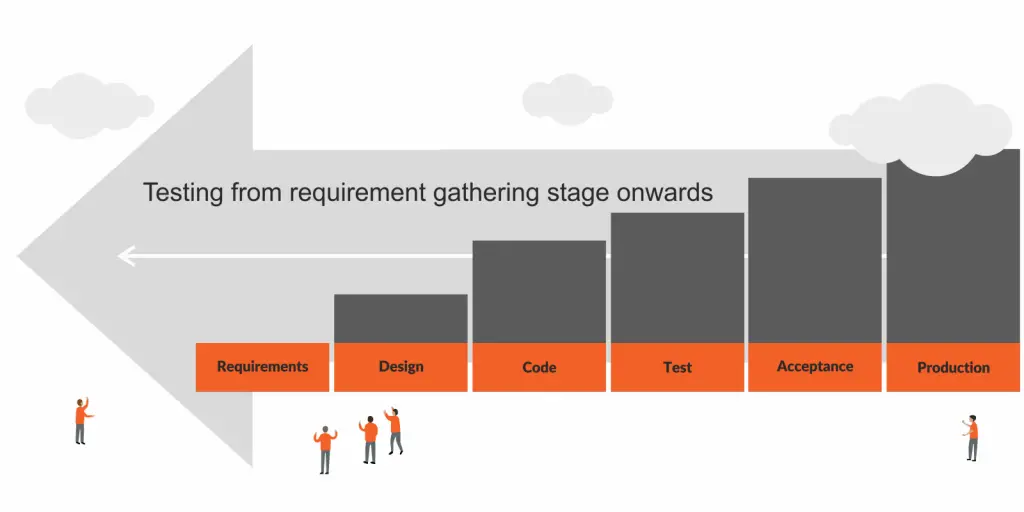What is shift left testing?
Shift left testing is the practice where testing is introduced at the inception stage of software development. Here, the teams emphasize prevention rather than detection and aim to enhance the overall quality of the software…Unlike traditional testing that takes place at a later stage of the development cycle, shift left, being conducted at the early stages, helps avert the significant number of different issues. It promotes insertion of quality assurance exactly from the necessary phase of development and moves down to the subsequent phases.
Download Whitepaper: Combination of Shift left and Shift right in DevOps
What drives the trend towards shift left testing?
In today’s business world where cut-throat competition has become an inherent part, organizations are constantly trying hard to reduce costs, increase revenue, weighing margins and speed up time to market. Thus, a lot depends on testing for giving the green signal to a bug-free, hitch-free software or application. For companies, some of the key questions are: How to save cost by avoiding delayed delivery? Why does it require tremendous effort to rectify the defects mid-way through the development? How to convince the management about the proper progress of development?
Most of the disruptive and common problems in software development field arise from technology, cost and time when it comes to delivering a solution to the clients. As per the traditional development models, testing begins when development reaches the coding phase. This essentially means that the majority of the testing pursuit aims the wrong developmental phase, missing more than half of the defects. There is a distant possibility of identification of these defects during the testing part. If they’re identified, it would mean upgrading the quality of degraded software.
Most of the significant problems become prominent when:
• Software development costs are quite high
• Delivery of the software is delayed
• Improper testing – resulting in business losses
• Software quality fails to meet the standards
No wonder that traditional software development propositions are becoming ineffectual to manage newer expectations.
But what if the defects are found early? Won’t it help avoid a lot of unnecessary trouble? The utmost importance of shift left testing comes into the picture right here. Even the cooks meticulously check the proportions of the ingredients they’re going to use to prepare a dish. So, why can’t it be done for a thousand dollar development project? What’s more, preventive measures provide multifold advantages – cost savings, risks reduction, scheduled delivery, well-timed rectification and so on.
Shift left testing helps rectify the defects as they happen and ensures no or very minimum existence of after-effects. In a nutshell, shift left is to improve the upstream quality. Identifying flaws earlier is the key. This could be achieved by introducing static testing requirements, boosting system test, assuring code quality among others.
Benefits of shift left testing (In agile setting)
Ideally, an individual on the team should be identified whose primary responsibility would be to analyze and suggest emerging technologies that empower the team to shift left continually. Instead of marking the testing period of a project as ‘fix phase’, shift left encourages testing in parallel to or with development activities. By integrating both key activities from day-1 of the project, namely development and quality assurance, shift left testing ensures cost-effectiveness while saving time and resources.
The agile setting is an alternative to traditional project management. It helps teams evaluate the mode of a project through the SDLC. It’s attained by performing iterative, incremental work cadences widely known as sprints. Agile testing is distinctly limited to developmental testing. Shift left testing is gaining popularity, especially in an agile setting, for the following benefits:
- Cost-effectiveness
- Saving resources and time
- Early detection and fixing of bugs
This model promotes better teamwork between developers and testers – by minimizing the frictional differences between teams.
It also
- allows adequate test coverage
- expedites delivery of the software
Final words
Shift left methodology is a highly influential and popular trend in the software testing community. It’s mainly intended to integrate testing into software/system engineering in a better manner and thereby find defects at an earlier stage when they’re less expensive and easier to fix. The less well-known fact, both inside and outside of the testing field, is that shift left testing comprises of four different variants – Traditional, Incremental, Agile/DevOps and Model-based. Each of these variants banks on each other to substantially improve effectiveness, efficiency and even the extent of testing.
Download Whitepaper: Testing & automation to increase the end user experience
Companies can leverage the shift-left approach to propel their organization towards a quicker, more predictive and preventive approach to testing, Contact – It functions remarkably well in agile environments but can be applied equally well across any other methodology as well.









